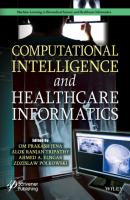Computational Intelligence and Healthcare Informatics. Группа авторов
Чтение книги онлайн.

Читать онлайн книгу Computational Intelligence and Healthcare Informatics - Группа авторов страница 14
Название: Computational Intelligence and Healthcare Informatics
Автор: Группа авторов
Издательство: John Wiley & Sons Limited
Жанр: Программы
isbn: 9781119818694
isbn:
1.5.1 Electronic Health Records
This is one aspect of healthcare where the biggest challenge was assimilating data generated in different forms and different sources and to be able to replicate it instantly for analysis. This helps not just the healthcare provider by keeping record of medical history, tests, and allergies but also keeps the patient informed of any tests or appointments due.
1.5.2 Helping in Diagnostics
With medicine moving toward a more preventive and predictive science and also generalized toward a more individualized science, big data analytics has assumed a more integral role. Use of large volumes of data in fields like radiology, pathology, and oncology helps in arriving at an early diagnosis with computer-assisted devices increasing the accuracy of diagnosis and helping in early intervention thereby improving outcomes.
1.5.3 Preventive Medicine
Wearable devices are the new healthcare providers in today’s times and they have an increasingly important role to play in medicine in the times to come. These devices are the new physicians which continue to monitor an individual at all times having not just diagnostic but also predictive value. These devices can monitor many parameters and can connect with physicians even far away.
1.5.4 Precision Medicine
In robotic surgeries especially neurosurgeries and oncosurgeries where precision is of utmost importance, big data and ML are combined to deliver results that lead to better outcomes with lesser morbidity and mortality, which is a boon for all stakeholders.
1.5.5 Medical Research
Advancements in medical research have gathered pace with the availability of big data and ML. With all the data at hand, researchers are forever trying to find better cures. Varied data available for analysis helps in understanding why a particular treatment modality worked in a population group while it failed to bring the desired response in another, blood thinners working in one patient population and not working in another is an example. Researchers are using genetic information to personalise drug treatments [25].
Using algorithms, scientists have been able to identify molecules that activate a particular protein which is relevant to symptoms of Alzheimer’s disease and schizophrenia; this could lead to early development of drugs for the treatment of these as yet incurable diseases [26].
1.5.6 Cost Reduction
With the availability of medical data, the healthcare provider gets all the background information of his patient helping him to make decisions with less errors, resulting in lower costs for the patient and the healthcare system. Analysis of data from a particular patient population helps in deciding disease management strategies improving preventive care, thereby minimizing costs.
1.5.7 Population Health
Big data availability leads to optimal use of the available resources for the entire community. It provides insights as to which patient population is especially vulnerable to a particular illness, so that measures can be taken to lessen the impact of a disease whether communicable or non-communicable by scaling up the facilities needed for its management so that the impact of the disease can be contained.
1.5.8 Telemedicine
Doctors recommend telemedicine to patients for personalized treatment solutions to prevent readmissions, and data analytics can then be used to make assessments and predictions of the course and associated management adjustments.
1.5.9 Equipment Maintenance
With connectivity between healthcare infrastructures for seamless real-time operations, its maintenance to prevent breakdowns becomes the backbone of the entire system.
1.5.10 Improved Operational Efficiency
The big data helps us understand the admission, diagnosis, and records of utilization of resources, helping to understand the efficiency and productivity of the hospital facilities.
1.5.11 Outbreak Prediction
With the availability of data like temperature and rainfall, reported cases reasonable predictions can be made about the outbreak of vector borne diseases like malaria and encephalitis, saving lives.
1.6 Challenges for Big Data
The volumes of data generated from diverse sources need to be sorted into a cohesive format and then be constantly updated so that it can be shared between healthcare service providers addressing the relevant security concerns, which is the biggest challenge. Insights gained from big data help us in understanding the pooled data better, thereby helping in improving the outcomes and benefitting insurance providers by reducing fraud and false claims.
The healthcare industry needs skilled data analysts who can sift out relevant data, analyze it, and communicate it to the relevant decision makers.
1.7 Conclusion
This chapter provides an overview regarding better healthcare services with the help of ML and big data technology. It presents big data approaches to gather valuable medical records and further the application of ML algorithm. The implementation of ML tool in medicine shows more accurate result with less processing time. Big data will surely help in collecting and maintaining EHR (electronic health records) for better decision-making in future. This paper provides a systematic review to the researchers about better options in the field of healthcare using ML and big data (Figure 1.5). This paper has identified several application areas in healthcare services using ML and big data which can further improve the unresolved challenges. The traditional healthcare services will be greatly transformed by such technologies. ML will help in improving the relationship between the locals and service provider by providing better service in less time. It will help in keeping an eye on critical patients in real time and help them diagnose the disease and recommend further treatment.
Figure 1.5 Applications of big data in healthcare.
References
1. James, M., Michael, C., Brad, B., Jacques, B., Big Data: The Next Frontier for Innovation, Competition, and Productivity, McKinsey Global Institute, New York, NY, 2011.
2. Al-Jarrah, O.Y., Yoo, P.D., Muhaidat, S., Karagiannidis, G.K., Taha, K., Efficient machine learning for big data: A review. Big Data Res., 2, 3, 87–93, Sep. 2015.
3. Beyer, СКАЧАТЬ